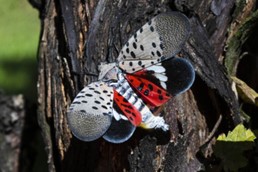Spotted Lanternfly is an invasive pest. VAAFM and partners have intercepted both live and dead insects and at this time not aware of any established populations in Vermont. The spotted lanternfly uses its piercing- sucking mouthpart to feed on sap from over 70 different plant species. It prefers to feed on grapevines, maple trees, black walnut, birch, willow, and other trees. The damage from its feeding may stress plants and trees that can lead to decreased health and potentially death. The sticky sweet material the insect excretes can also cause stress in plants by preventing photosynthesis when it coats leaves, or cause property damage and attract stinging insects impacting enjoyment of the outdoors.
sucking mouthpart to feed on sap from over 70 different plant species. It prefers to feed on grapevines, maple trees, black walnut, birch, willow, and other trees. The damage from its feeding may stress plants and trees that can lead to decreased health and potentially death. The sticky sweet material the insect excretes can also cause stress in plants by preventing photosynthesis when it coats leaves, or cause property damage and attract stinging insects impacting enjoyment of the outdoors.
Common Questions
Is there an established spotted lanternfly population in Vermont?
No. The VAAFM has intercepted both living and dead adult spotted lanternflies, but there are no known reproducing population of SLF in the state. While not an assurance, the Agency understands that it may be unlikely that SLF will become established due to Vermont’s climate, however nurseries and the public must be vigilant to prevent introduction.
Is spotted lanternfly under a federal quarantine?
SLF is not under Federal quarantine, but individual states have established internal quarantines in an effort to slow the spread of this invasive pest. Individual states regulate the movement of certain commodities and other regulated articles, and maintain compliance agreements with industries that may be a high-risk pathway for SLF to spread (e.g. nurseries and trucking companies).
Is there an external quarantine?
No. Vermont relies on infested state internal quarantines to prevent spread outside of these state quarantine areas (e.g. compliance agreements and permitting systems between regulated industries and state departments of agriculture).
What agricultural problems do they cause?
Spotted lanternfly can seriously impact crops such as grapes, and can damage young, small plants and adversely affect growth. It is also considered a nuisance pest.
What the Agency is doing?
Spotted lanternfly can travel on nursery stock. Reducing the likelihood of spreading Spotted lanternfly through the nursery trade will reduce impacts to businesses, customers, agriculture and the environment. VAAFM works directly with the nursery industry, asking them to employ the following practices:
- Inspect nursery stock for egg masses, live or dead insects
- Report to VAAFM when egg masses, live or dead insects are found
- Respond to the find appropriately, including scraping egg masses or treating nursery stock to prevent spread of the invasive pest.
If the Agency receives a report from the nursery industry it will follow up to try to determine:
- The origin state of the spotted lanternfly and if infested stock was further sold or spread,
- if there is a risk for establishment of a reproducing population,
- if monitoring is necessary, and
- opportunities for further education and support
In addition to outreach and education designed for regulated industries concerning the spread of spotted lanternfly, VAAFM also conducts outreach and education to the general public on:
- how to identify all life stages,
- recommends inspecting deliveries from known infested areas, and
- urges visitors to quarantine zones to take precautions to prevent harborage and transport of spotted lanternfly life stages.

Additional Resources
- Spotted Lanternfly | Vermont Invasives (vtinvasives.org)
- To report spotted lanternfly, https://vtinvasives.org/reporting-spotted-lanternfly
- Spotted Lanternfly tutorial, https://youtu.be/BKSul9K3A30 (
- Spotted Lanternfly and Nursery Stock: reducing establishment, https://youtu.be/V8xpExYmd24
- Distribution map: https://nysipm.cornell.edu/environment/invasive-species-exotic-pests/spotted-lanternfly/
